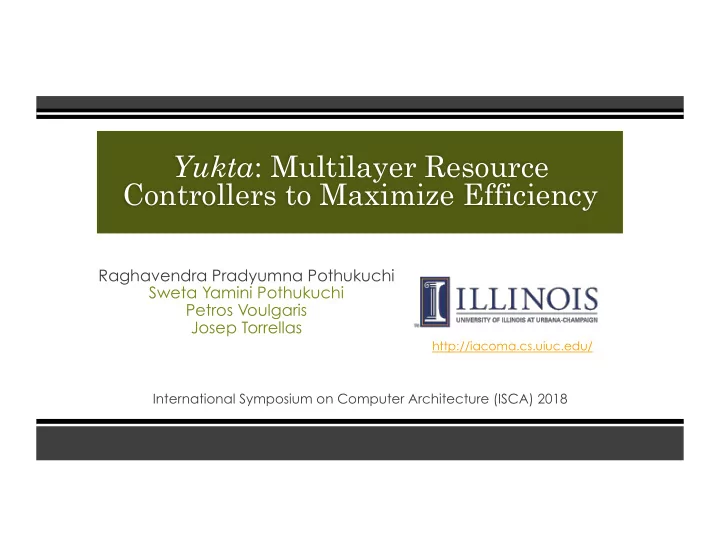

Yukta : Multilayer Resource Controllers to Maximize Efficiency Raghavendra Pradyumna Pothukuchi Sweta Yamini Pothukuchi Petros Voulgaris Josep Torrellas http://iacoma.cs.uiuc.edu/ International Symposium on Computer Architecture (ISCA) 2018
Resource Management in Computers Configurable parameters Frequency Scheduling Many objectives Limited resources Energy Storage Fairness Performance Thermals Resource Management System
Designing Computer Resource Management Systems Application OS/Runtime Hardware Different resources, parameters and design teams! Modular Coordinated Handle uncertainty 3
Contributions of This Work ▪ Propose Robust Control Theory for computer resource management – Describe why robust control theory is essential for computers ▪ Develop Yukta, a modular approach for coordinated multilayer control – Present how robust control theory is applied to multilayer resource management ▪ Prototype Yukta on an ARM big.LITTLE octacore running Ubuntu – 37% better performance and 20% lower energy than state-of-the-art 4
Why Robust Control Theory is Suitable for Computers? - I ▪ Robust control theory: Branch of control theory for uncertain environments System Robustness to uncertainty Uncertainty Model enables optimality under modularity ▪ Designers set a guardband for the amount of uncertainty to tolerate – 60% guardband ⇒ controller’s guarantees hold even if model is off by 60% ▪ Computer control faces many forms of uncertainty – Partial system view, controller interference, program behavior, limited modeling… 5
Why Robust Control Theory is Suitable for Computers? - II ▪ Robust controllers have input channels for communication External signals #Tasks (from OS) Targets Outputs Inputs Robust System Conventional _ + e.g., power e.g., power target Controller Controller e.g., frequency (Processor) We use Externals signals for controller communication 6
Why Robust Control Theory is Suitable for Computers? - III ▪ Can work with discretized inputs as common in computers – E.g., core frequency, 𝑔 ∈{2 ¡ 𝐻𝐼𝑨 , ¡2.2 ¡ 𝐻𝐼𝑨 ¡…3 ¡ 𝐻𝐼𝑨 } ▪ Guarantee precise bounds on meeting targets – E.g., core power can be kept within ± 0.05 W of the power target Robust control theory is highly desirable for computer systems 7
Yukta: Multilayer Robust Controllers min _ E × D Targets Inputs Outputs Robust Layer 2 + Optimizer Controller (OS) Design External signals Multilayer #Tasks (from OS) goals system Targets Inputs Outputs Robust Layer 1 _ + Optimizer e.g., e.g., power Controller e.g., frequency (Processor) power target min E × D Modularly designed and guaranteed optimal behavior First to propose robust control for modular multilayer management 8
Automated Synthesis of the Robust Controller ▪ Designer provides a model, and: – Output deviation bounds ( 𝐶 ) : e.g, ± 0.05W for power deviations – Input weights ( 𝑋 ) : Relative overheads – Discrete input values ( Δ ↓ in ) – Uncertainty guardbands ( Δ ↓𝑣 ) : Degree of desired robustness System 𝑪 𝑿 𝒐 𝚬 ↓𝒗 ↓𝒗 𝚬 ↓𝒋𝒐 Inputs Targets Observed Robust _ + Model Outputs Deviations Controller Nominal loop 9
Automated Synthesis of the Robust Controller ▪ Designer provides a model, and: – Output deviation bounds ( 𝐶 ) : e.g, ± 0.05W for power deviations – Input weights ( 𝑋 ) : Relative overheads – Discrete input values ( Δ ↓ in ) – Uncertainty guardbands ( Δ ↓𝑣 ) : Degree of desired robustness Structured Singular Value 𝑻𝑻𝑾 𝑻𝑻𝑾 ( 𝑶 ,𝚬) Can the controller guarantee the bounds optimally 𝚬 even under uncertainty as big as the guardband? Synthesis is automated! Nominal loop Observed 𝑶 Targets Outputs 10
Designing Multilayer Controllers Select Decide Set Obtain Design external inputs, controller controller model outputs signals parameters Modular and practical design Layer 1, e.g. OS team Layer 2, e.g. Hardware team Interface Decide Select Set Design Obtain inputs, external controllers controller model signals outputs parameters 11
Prototype Yukta on a Challenging System Minimize Energy × Delay under thermal and power constraints 12
Prototyped Yukta Architecture 13
Designing Robust Controllers for the Prototype Decide Select Select Decide Set Set Design Design Obtain Obtain inputs, inputs, External External controller controller model model controller controller outputs outputs signals signals parameters parameters Interface Interface Data driven modeling (System Identification): 2 benchmarks each from SPECint, SPECfp and PARSEC OS Robust Controller § Output deviation bounds § Input weights HW Robust § Input discretization Controller § Uncertainty guardband 14
Evaluation Industry based [ISCA’16] Coordinated Monolithic Yukta: Multilayer heuristics non-robust robust Average across 8 PARSEC and 6 SPEC (multiprogrammed) workloads Yukta makes the system 37% faster with 20% lower energy ⇒ 50% better ED 15
Summary ▪ Dynamic resource management must meet many goals simultaneously ▪ Resource controllers should be modular and coordinated ▪ We propose using Robust Control Theory for computer management – Optimized for uncertainty ▪ We develop Yukta for formal multilayer resource management ▪ Prototype demonstrates significant advancement – 50% reduced Energy × Delay on average ▪ Yukta is essential for resource efficient computing 16
Concluding Remarks ▪ More details in the paper – Mathematical background of the Robust Controller – Yukta design details – Prototype design choices – Comparison with other designs and heterogeneous workloads – Sensitivity analysis ▪ Future work – Heterogeneous components in a layer – Hierarchical organization of controllers 17
Yukta: Energy × Delay minimization 22
Yukta: Energy × Delay minimization 23
Case Study with blackscholes 24
Yukta: blackscholes 25
Yukta: Comparison with LQG control 26
Yukta: Heterogeneous Workloads 27
Yukta: Sensitivity to Uncertainty Guardbands 28
Yukta: Sensitivity to Output Bounds 29
Yukta: Sensitivity to Input Weights 30
Recommend
More recommend